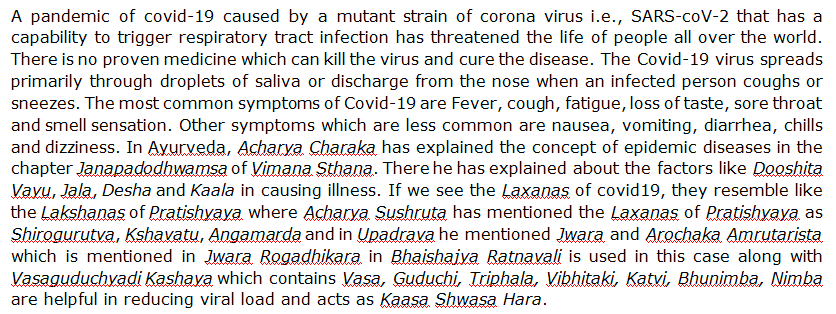Effect of Vasaguduchyadi Kashaya in improving oxygen saturation in Covid patient - A Case Report
DOI:
https://doi.org/10.21760/jaims.v6i4.1378Keywords:
Janapadodhwansa, Pratishyaya, Covid-19, Jwara, Kaasa.Abstract
A pandemic of covid-19 caused by a mutant strain of corona virus i.e., SARS-coV-2 that has a capability to trigger respiratory tract infection has threatened the life of people all over the world. There is no proven medicine which can kill the virus and cure the disease. The Covid-19 virus spreads primarily through droplets of saliva or discharge from the nose when an infected person coughs or sneezes. The most common symptoms of Covid-19 are Fever, cough, fatigue, loss of taste, sore throat and smell sensation. Other symptoms which are less common are nausea, vomiting, diarrhea, chills and dizziness. In Ayurveda, Acharya Charaka has explained the concept of epidemic diseases in the chapter Janapadodhwamsa of Vimana Sthana. There he has explained about the factors like Dooshita Vayu, Jala, Desha and Kaala in causing illness. If we see the Laxanas of covid19, they resemble like the Lakshanas of Pratishyaya where Acharya Sushruta has mentioned the Laxanas of Pratishyaya as Shirogurutva, Kshavatu, Angamarda and in Upadrava he mentioned Jwara and Arochaka Amrutarista which is mentioned in Jwara Rogadhikara in Bhaishajya Ratnavali is used in this case along with Vasaguduchyadi Kashaya which contains Vasa, Guduchi, Triphala, Vibhitaki, Katvi, Bhunimba, Nimba are helpful in reducing viral load and acts as Kaasa Shwasa Hara.
Downloads
References
Sharma P.V.,editor. Vol. 1. Chaukamba Orientalia; Varanasi:2012.p.316 (charaka Samhita(text with English translation), Vimanasthana, chapter 3, verse 13-14
Vaidya jadavji trikamji., editor. Chaukamba Orientalia; Varanasi: 2014 (sushruta Samhita dalhanacharya tika), Uttara sthana, chapter 24, verse 5
Kaviraj Govind Das Sen, Bhaishajya Ratnavali, Chaukamba Orientalia Varanasi:2015 chapter 5, verse122.
Vaidya jadavji trikamji., editor. Chaukamba Orientalia; Varanasi:2014(Sushruta Samhita with nibhanda sangraha commentary Sanskrit), chikitsa sthana chapter 9, verse 3.
Vaidya jadavji trikamji., editor. Chaukamba Orientalia; Varanasi:2014(sushruta Samhita with nibhandasangraha commentary Sanskrit), Uttara sthana , chapter 24, verse 4.
Robins and Cotran , pathologic Basis of Diseases vol 1; south Asia edition ; Reed Elsevier India pvt limited 2014 , chapter 6, pg no:196.
Brahmanand Tripathi; editor.Chaukamba Sanskrit pratisthana; Delhi:2014(Astanga hrdayam of acharya vaghbhata hindi commentary) , sutrasthana , chapter12, verse 23.
Acharya P.V Sharma; prof dept of dravya guna; Text book of dravya guna -vijnyana ;vol 2: Chaukamba Orientalia; Varanasi: 2013; chapter 9 .
https://ijpsr.com/bft-article/tinospora-cordifolia-a-phytopharmacological-review; cited 18/6/2021
Acharya P.V Sharma; Prof dept of dravya guna ; Text book of dravya guna vigyana; Vol 2: chaukamba Orientalia; Varanasi :2013; chapter 4.
Vaidya Jadavji Trikamji; editor; chaukamba Orientalia Varanasi; 2015( Charaka Samhita with Agnivesha commentary) chapter 8 , verse 25
Brahmanand Tripati; editor; Chaukamba Orientalia; Delhi;2014(Astanga hrudaya of Acharya Vagbhata hindi commentary), Uttara sthana; chapter 20, verse – 15.















